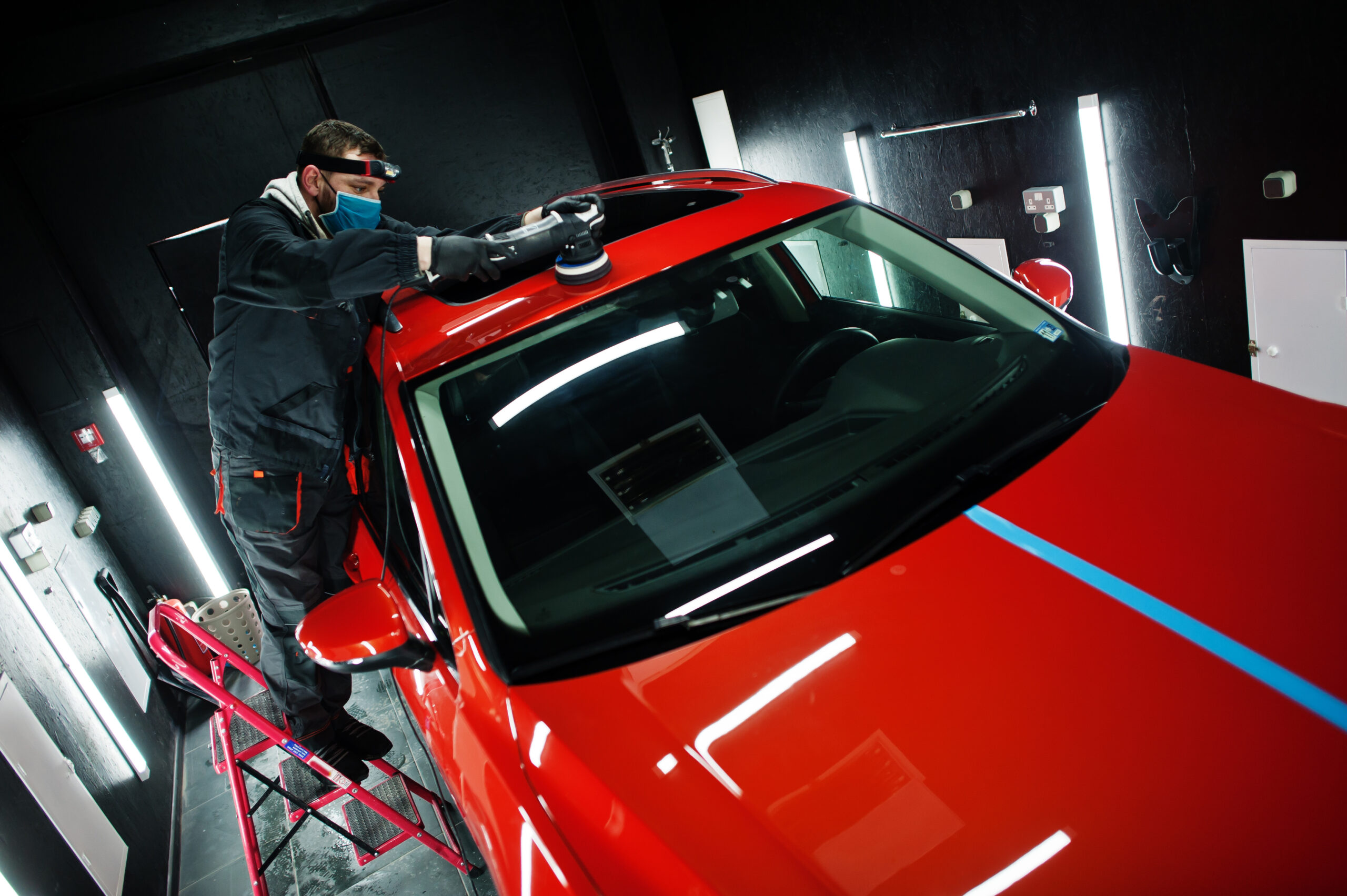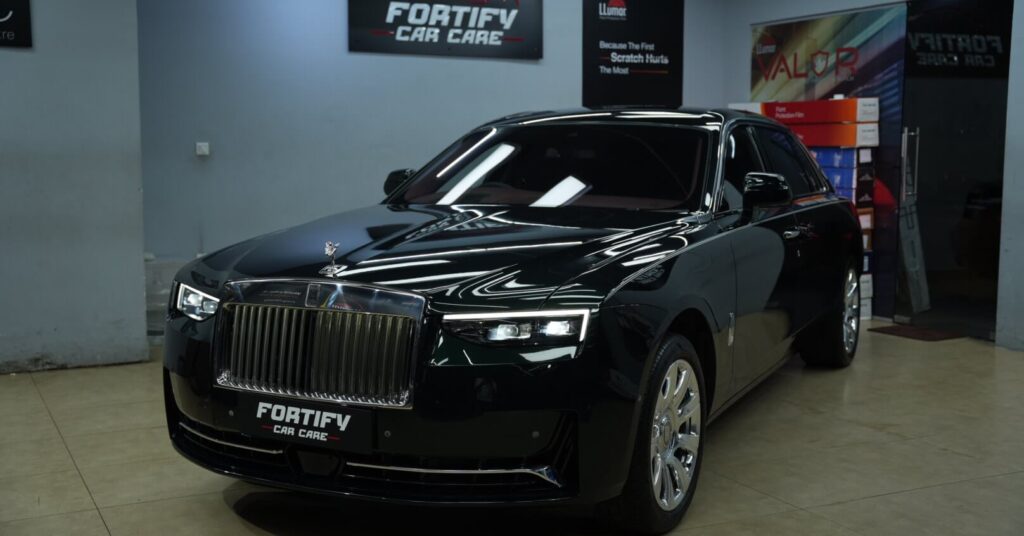Do you want to protect your luxury car from scratches, bird droppings, and dust? If yes, then you’re at the right place. Today, we’re going to reveal the best and most demanding coating for a car, which enhances its durability and provides resistance to environmental damage. Being a responsible car owner, it is an utmost priority to make every possible effort to let your luxury car shine. When it comes to maintaining your car’s pristine appearance, ceramic coating is a more reliable and effective coating that one should go for.
But what exactly is car ceramic coating, and why has it become a buzzword in the automotive detailing world? Let’s delve into the world of ceramic coating for cars, exploring their benefits, application process, maintenance, best place to get it done, and their comparison to other paint protection methods.
Understanding Ceramic Coating
Ceramic coating is a liquid polymer applied to a vehicle’s exterior surfaces. Once applied, it forms a chemical bond with the factory paint, creating a durable, hydrophobic layer that offers enhanced protection against environmental contaminants. Unlike traditional waxes or sealants, ceramic coating for cars provides long-lasting defence, often enduring for several years with proper maintenance.
How Does Ceramic Coating Work?
Ceramic coating is a liquid polymer applied to the exterior of vehicles to provide a long-lasting protective layer. It is primarily made from silicon dioxide (SiO₂), derived from natural materials such as quartz and sand. When applied correctly, car ceramic coating chemically bonds with the vehicle’s factory paint, creating a semi-permanent or even permanent protective shield.
The process begins with meticulous surface preparation. Before applying the ceramic coating, the vehicle’s surface must be thoroughly cleaned, decontaminated, and sometimes polished to remove swirl marks, scratches, or any wax residues. This step is crucial because the coating needs to bond directly to the paint, and any imperfections left behind will be sealed underneath.
Once the surface is prepped, the ceramic coating is carefully applied in small sections using a soft applicator pad. As it’s spread across the surface, it begins bonding at the molecular level with the vehicle’s clear coat. This chemical bonding sets ceramic coating apart from traditional waxes or sealants, which only sit on the surface and wash off over time.
After application, the coating requires a curing period, usually ranging from 24 to 48 hours. During this time, it hardens into a transparent, glass-like layer. Professional-grade coatings may use infrared curing lamps to accelerate and enhance the curing process. Once cured, the result is a sleek, hydrophobic layer that offers multiple benefits.
One of the key advantages of ceramic coating for cars is its hydrophobic properties. This means that water beads up and rolls off the surface, taking dirt and contaminants with it. As a result, the vehicle stays cleaner for longer, and washing becomes much easier. Additionally, ceramic coatings protect against UV rays, preventing paint oxidation and fading over time.
However, it’s important to understand what ceramic coating does not do. It won’t eliminate the need for regular washing, it won’t protect against rock chips or deep scratches, and it doesn’t replace paint protection films. Moreover, while ceramic coatings are long-lasting, they are not eternal—most high-quality coatings last between 2 and 5 years, depending on the product and maintenance.
Benefits of Ceramic Coating for Cars
Ceramic coating has gained immense popularity among car enthusiasts and everyday drivers alike, thanks to its advanced protective qualities and long-lasting effects. Unlike traditional waxes and sealants that wear off quickly, ceramic coatings provide a semi-permanent layer of protection that bonds with the car’s surface. Below are ten major benefits of ceramic coating for cars, explained in detail:
1. Long-Lasting Protection
Ceramic coatings offer a durable shield that can last for years. While waxes typically wear off in a few weeks or months, a high-quality ceramic coating can last 2 to 5 years, or even longer with proper maintenance. This reduces the frequency of reapplication and saves time and effort in the long run.
2. Hydrophobic Properties (Water Repellent)
One of the standout features of ceramic coating is its hydrophobic nature. Water beads up and rolls off the surface, taking dirt, grime, and other contaminants with it. This makes washing the car much easier and helps keep it cleaner for longer periods.
3. UV and Sun Protection
Exposure to UV rays can cause a car’s paint to oxidize and fade over time. Ceramic coating acts as a barrier against harmful ultraviolet radiation, preserving the paint’s original color and shine and preventing it from dulling due to sun exposure.
4. Protection from Chemical Stains
Bird droppings, tree sap, acidic rain, and bug splatter can cause permanent stains or damage to your car’s surface. Ceramic coating resists chemical etching and minimizes the risk of such stains bonding with the paint, making them easier to clean off.
5. Enhanced Gloss and Shine
Ceramic coating enhances the depth and clarity of your car’s paint, giving it a sleek, glossy, and showroom-like finish. The coating improves the reflective properties of the paint, which is especially noticeable on darker-colored vehicles.
6. Scratch and Swirl Resistance
While ceramic coating is not completely scratch-proof, it adds a level of hardness to the surface, making it more resistant to light scratches and swirl marks caused by improper washing or wiping. This helps maintain a smoother, blemish-free finish.
7. Ease of Cleaning and Maintenance
Dirt, mud, and grime do not stick easily to ceramic-coated surfaces. Because of the slick, hydrophobic layer, regular washing becomes less labor-intensive. You’ll also find that fewer harsh chemicals or tools are needed to clean the car.
8. Cost-Effective in the Long Run
Though ceramic coating may have a higher initial cost compared to wax, its longevity makes it a more economical option over time. With fewer trips to the car detailer and fewer frequent applications, you ultimately save money on car care.
9. Resale Value Enhancement
A well-maintained, ceramic-coated car looks newer for longer, helping to preserve its resale value. Buyers are often more interested in cars that look pristine and have been properly protected from wear and tear.
10. Protection Against Environmental Hazards
From bird droppings to road salts and industrial fallout, ceramic coating forms a barrier that protects against a wide range of environmental pollutants. This is especially valuable if you live in areas with harsh climates, industrial pollution, or salty roads during winter.
Graphene Ceramic Coating: The Next Evolution
Recently, graphene ceramic coatings have emerged as an advanced alternative to traditional ceramic coatings. Incorporating graphene—a single layer of carbon atoms known for its strength and conductivity—these coatings offer enhanced durability, better heat dissipation, and even greater resistance to water spots and contaminants.
Ceramic Coating vs. Paint Protection Film (PPF)
While ceramic coatings provide excellent protection against environmental elements and minor scratches, they don’t offer the same level of impact resistance as Paint Protection Film (PPF). PPF is a thicker, transparent film applied to the car’s surface, offering superior protection against rock chips, road debris, and other physical impacts. For comprehensive protection, some car owners opt to use both PPF and ceramic coating in tandem.
Application Process of Ceramic Coating
Applying car ceramic coating is a meticulous process that requires attention to detail, a clean environment, and proper technique to ensure effective bonding and long-lasting protection. Whether done professionally or as a DIY project, the steps are generally similar. Here’s a breakdown of the full ceramic coating application process:
1. Thorough Wash
Before anything else, the car must be washed thoroughly to remove loose dirt, dust, and grime.
- Use a pH-neutral car shampoo.
- Rinse off all residues, including previous waxes or sealants.
2. Decontamination
This step removes embedded contaminants that cannot be cleaned with a simple wash.
- Iron remover or tar remover is applied to dissolve brake dust, industrial fallout, and tar.
- A clay bar is then used to pull out any remaining particles from the paint surface.
3. Paint Correction (Polishing)
Paint correction is often necessary to remove swirl marks, fine scratches, oxidation, and imperfections.
- This is done using a dual-action (DA) polisher and polish compound.
- It ensures the surface is smooth and defect-free, which is crucial because ceramic coating locks in anything underneath it.
4. Surface Prep (IPA Wipe Down)
After polishing, the surface is wiped down with isopropyl alcohol (IPA) or a dedicated panel wipe.
- This step removes any leftover polish oils or residues.
- It ensures a clean, bare surface for the ceramic coating to bond properly.
5. Ceramic Coating Application
This is the main step of the process.
- A few drops of the ceramic coating are applied to a microfiber applicator pad.
- The coating is spread evenly across a small section (typically 2×2 ft).
- Allow the coating to sit for 30 seconds to 2 minutes (depending on the product and temperature).
6. Buffing Off Excess
Once the coating flashes (appears rainbow-like or hazy), it’s time to buff off the excess:
- Use a clean microfiber towel to gently buff the surface.
- A second towel is used to ensure no streaks or high spots remain.
7. Layering (Optional)
Some ceramic coatings allow for multiple layers to increase thickness and durability.
- Wait for the recommended curing time between layers (usually 1–2 hours).
- Apply and buff off additional layers the same way as the first.
8. Curing Time
After the entire vehicle is coated:
- Allow it to cure indoors or under shade for 24 to 48 hours.
- Avoid exposure to water, dust, or contaminants during this time.
- Some professionals use infrared heat lamps to speed up the curing process.
Aftercare Tips:
- Do not wash the car for at least 7 days after application.
- Use pH-neutral shampoos and avoid harsh chemicals.
- Regularly inspect and maintain with ceramic-safe products to prolong the coating’s life.
Maintenance Tips for Ceramic-Coated Cars
A car ceramic coating offers long-term protection and a stunning glossy finish, but to enjoy its full benefits, proper maintenance is essential. While it drastically reduces the effort required to keep your car clean, it doesn’t make your car maintenance-free. Follow these key maintenance tips to extend the life and performance of your ceramic coating:
1. Avoid Washing for the First 7 Days
After applying ceramic coating, let it cure for at least 7 days before any water or chemical exposure. This ensures the coating bonds properly to the paint and forms a durable layer.
2. Use pH-neutral Car Shampoo
Always use a pH-balanced or ceramic-coating-safe car shampoo. Harsh soaps or detergents can degrade the coating over time.
- Avoid dish soap or any household cleaner.
- Wash with the two-bucket method to minimize scratches.
3. Wash Your Car Regularly
Despite its hydrophobic properties, ceramic-coated cars still need to be washed regularly—ideally every 2-3 weeks.
- This prevents the buildup of contaminants like pollen, bird droppings, or road salts.
- Letting these sit can reduce the coating’s effectiveness.
4. Avoid Automatic Car Washes
Stay away from automatic brush-based car washes, as the harsh bristles can cause micro-scratches and wear down the coating.
- Opt for hand washing or touchless car washes instead.
5. Dry Properly After Washing
Use a clean, plush microfiber towel or a car dryer blower to avoid water spots and swirl marks.
- Never air dry in direct sunlight, as it may leave watermarks.
6. Use a Ceramic Coating Booster
To maintain slickness and hydrophobicity, apply a ceramic coating maintenance spray or topper every 2-3 months.
- These products help refresh the coating and extend its lifespan.
7. Park in the Shade or Under a Cover
Whenever possible, park your car in a shaded area or use a car cover.
- This minimizes UV exposure and helps prevent water spots from forming on the surface.
8. Remove Contaminants Promptly
Address bird droppings, bug splatter, and tree sap immediately.
- Use a dedicated quick detailer or ceramic-safe cleaner to wipe them off gently without damaging the coating.
9. Inspect and Decontaminate Twice a Year
Even coated cars can build up iron particles and other contaminants.
- Use an iron remover and a clay towel every 6 months to deep clean and decontaminate the surface.
- This helps maintain the coating’s performance.
10. Avoid Harsh Chemicals and Abrasives
Do not use strong solvents, abrasives, or acidic cleaners on the coated surface.
- They can strip away the coating and dull the shine.
- Stick with products specifically designed for ceramic-coated vehicles.
Common Misconceptions About Ceramic Coating
Ceramic coating is often hailed as a revolutionary product in car care, offering long-lasting protection and a brilliant shine. However, as its popularity has grown, so have the myths and misconceptions surrounding it. Understanding the truth behind ceramic coating for cars helps set realistic expectations and ensures that car owners make informed decisions. Below are some of the most common misconceptions about ceramic coating—debunked:
1. Ceramic Coating Makes My Car Completely Scratch-Proof
Reality: Ceramic coating adds a layer of hardness that can resist minor scratches and swirl marks, but it is not invincible. It can’t protect against rock chips, deep scratches, or deliberate damage. It simply makes the surface more resistant, not immune.
2. I’ll Never Have to Wash My Car Again
Reality: This is one of the most popular myths. While ceramic coating has hydrophobic properties that make dirt and water slide off more easily, it doesn’t eliminate the need for cleaning. Your car will still collect dust, pollen, and contaminants, and needs regular maintenance.
3. It Will Last a Lifetime
Reality: Although ceramic coatings are longer-lasting than wax or sealants, they don’t last forever. Most professional coatings last 2 to 5 years, depending on quality, driving conditions, and maintenance. Lifetime warranties usually require professional inspections and upkeep.
4. Ceramic Coating Fixes Paint Imperfections
Reality: Car ceramic coating does not hide or correct swirl marks, scratches, or faded paint. In fact, it may enhance imperfections if the surface is not properly prepared. That’s why paint correction is often done before application.
5. DIY Kits Offer the Same Results as Professional Coating
Reality: DIY ceramic kits have improved, but they are not as durable or effective as professional-grade coatings applied by certified detailers. The difference lies in the formulation, tools, preparation process, and expertise involved.
6. It’s Only for High-End or Luxury Cars
Reality: Ceramic coating benefits any type of vehicle, regardless of make, model, or price. Whether it’s a daily commuter or a premium sports car, any vehicle exposed to the elements can gain from the protection and shine that a ceramic coating offers.
7. I Don’t Need Maintenance After Ceramic Coating
Reality: This is a major misconception. Ceramic-coated cars still require regular maintenance to ensure the coating performs well over time. Skipping maintenance can lead to a buildup of contaminants and degrade the coating prematurely.
8. All Ceramic Coatings Are the Same
Reality: Ceramic coatings vary greatly in terms of formulation, durability, and performance. Some are silica-based, while others may include titanium dioxide or graphene. Cheap coatings often offer minimal protection and durability.
9. Ceramic Coating Replaces Wax and Sealants Entirely
Reality: While ceramic coatings outperform waxes and sealants in durability, some detailers still recommend layering with ceramic boosters or maintenance sprays for enhanced results. It’s more of an upgrade than a complete replacement in car care.
10. Water Spots Can’t Form on Ceramic Coated Cars
Reality: While ceramic coatings repel water, water spots can still form minerals in the water dry on the surface. The difference is, they’re easier to clean and less likely to etch into the paint.
Conclusion
Ceramic coating is a valuable investment for car owners seeking to preserve their vehicle’s appearance and protect it from environmental hazards. By understanding its benefits, application process, and maintenance requirements, you can make an informed decision on whether it’s the right choice for your car. If you care about your car, ceramic coating is more than just worth it — it’s essential. It’s not just about making your vehicle look good, but also about protecting what you value from environmental damage, wear, and aging.
And if you want the job done right, Fortify Car Care is your trusted expert in car ceramic coating and graphene ceramic coating solutions. For those seeking the latest in paint protection technology, graphene ceramic coating offers an advanced solution with superior performance
Frequently Asked Questions
With proper maintenance, ceramic coatings can last between 2 and 5 years, depending on the product quality and environmental conditions
While DIY kits are available, professional application ensures better durability and finish.
Ceramic coatings offer limited protection against rock chips. For better defense, consider combining it with paint protection film.
Yes, ceramic coatings can be applied to various vehicles, including cars, motorcycles, and boats.



